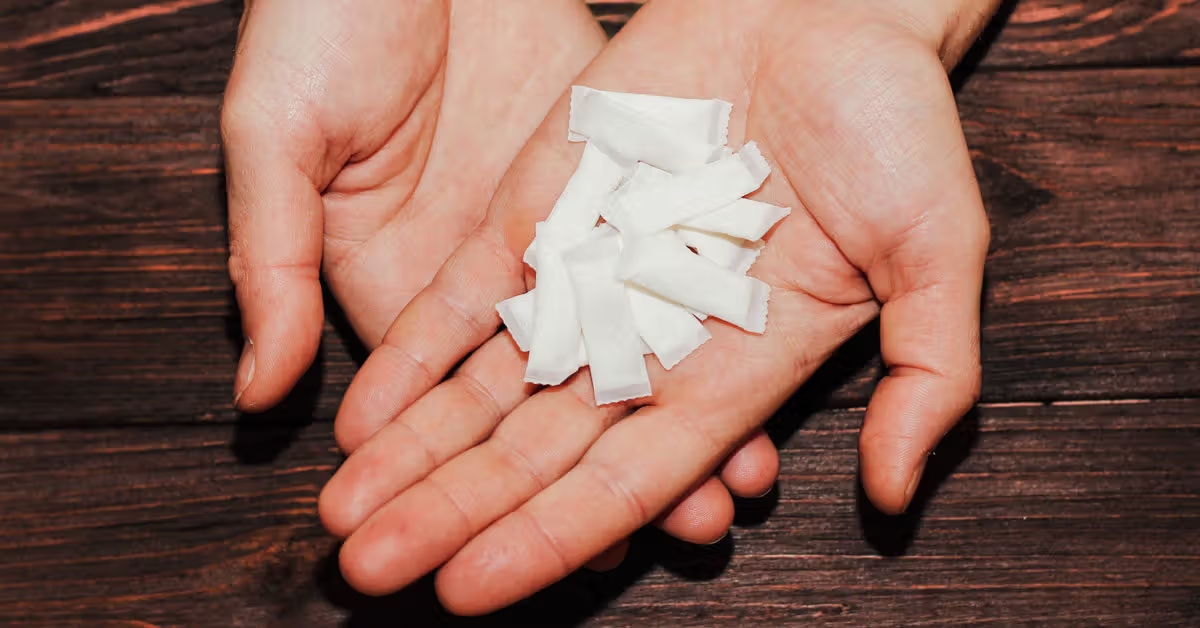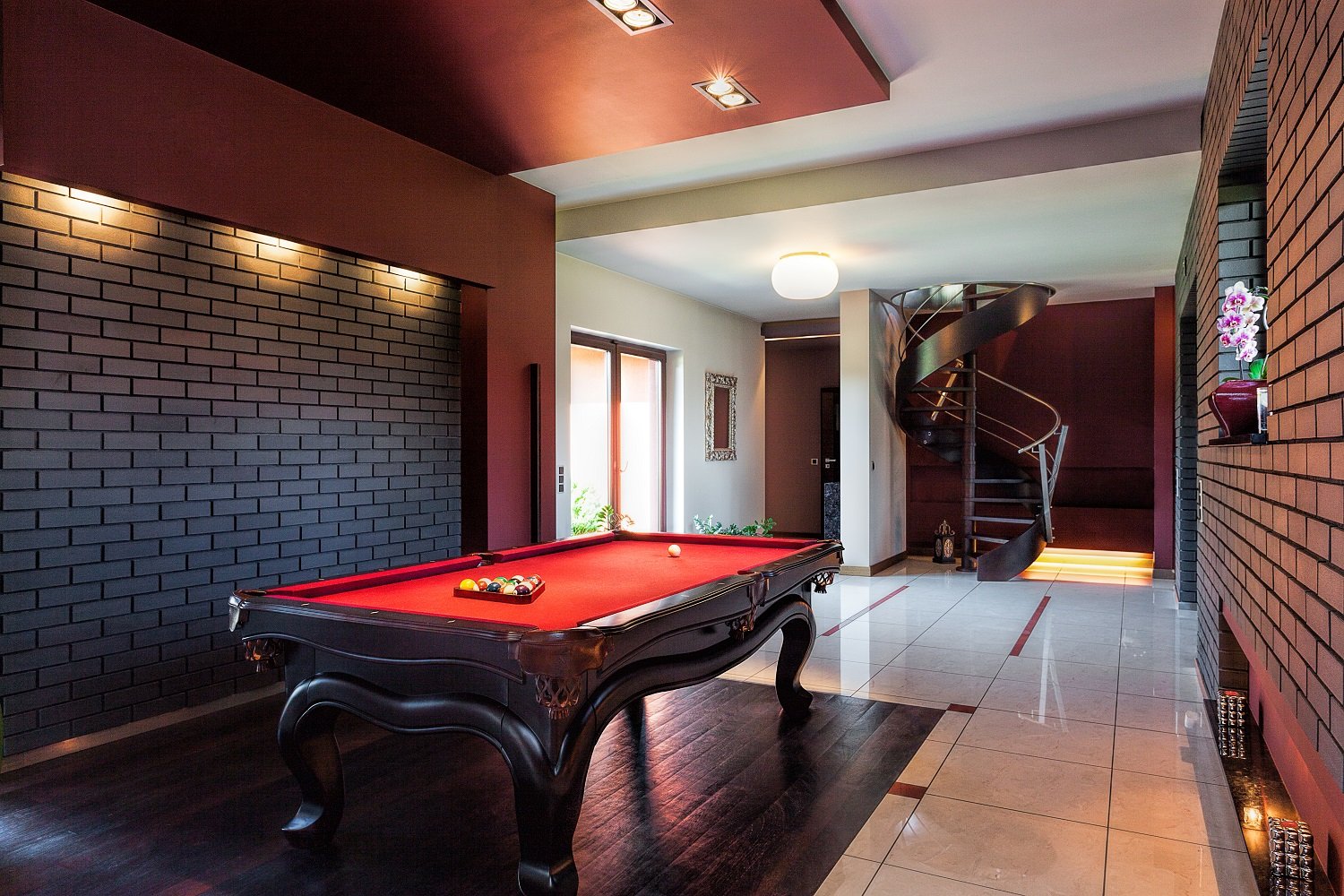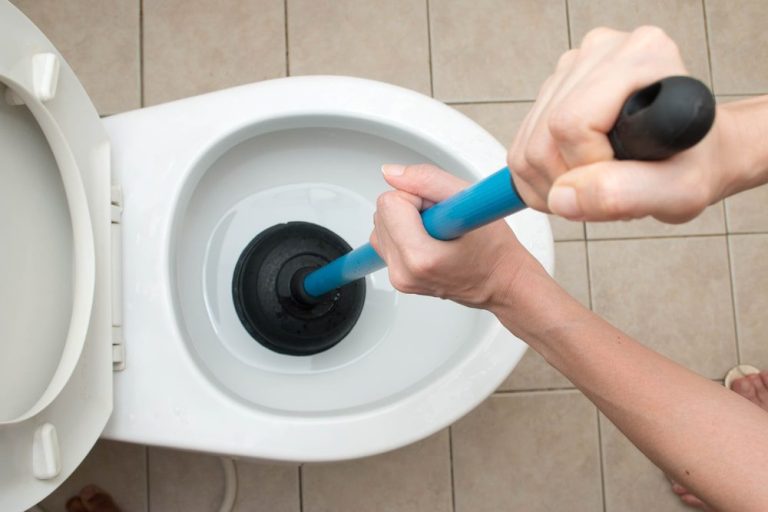Art Meets Functionality in the World of Resin Tables
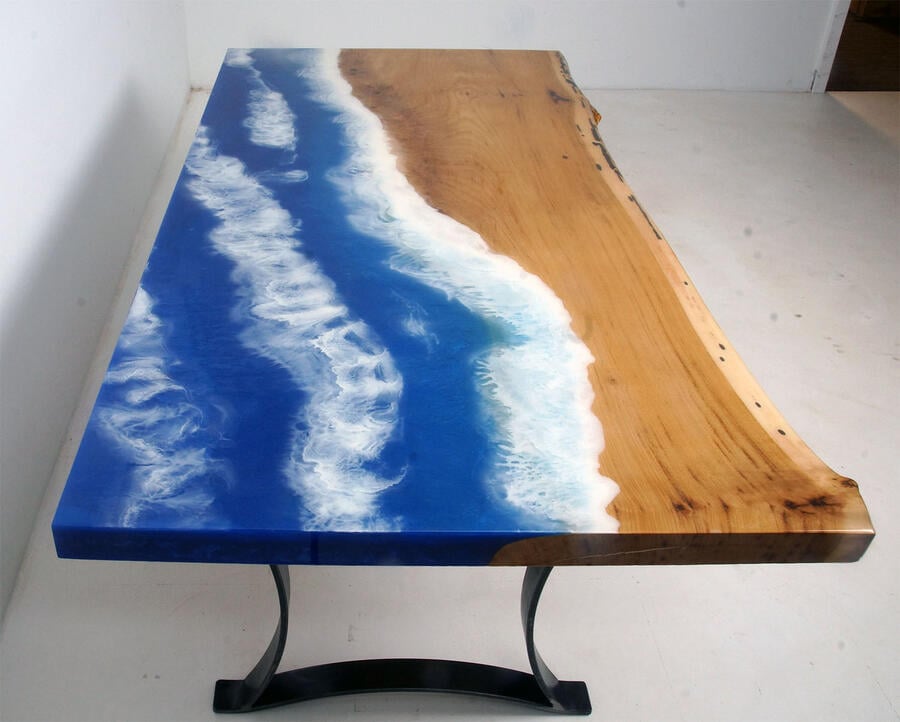
Table of Contents
In recent years, the fascination with epoxy-crafted furniture has taken a prominent spot in the landscape of modern home decoration, establishing a notable influence within contemporary settings. This growing trend transcends mere passing interest, embodying a deep-seated admiration for the seamless marriage of practicality and visual charm these pieces bring to living spaces.
Celebrated for their exceptional sturdiness and captivating aesthetic allure, such tables have emerged as coveted additions for individuals eager to enhance their interiors with an element of elegance and distinctiveness.
The core attraction of these epoxy masterpieces lies in their adaptability and the boundless creativity they unlock in design. Created from epoxy compounds, often married with organic materials like wood, these furnishings portray a range of imagery, from tranquil, oceanside views to lively, abstract patterns. The outcome transcends conventional furniture boundaries; it becomes a personal declaration, an art piece mirroring the proprietor’s preferences and aesthetic leanings.
Moreover, the resilience of resin tables positions them as a prime selection for environments ranging from active family homes to impressive ceremonial spaces. Their capability to resist stains, scratches, and everyday wear ensures they retain their exquisite look with minimal upkeep. This fusion of enduring quality and visual appeal confirms that such tables serve not merely as functional items within a dwelling but as focal points that elicit admiration and dialogue.
As we explore further into the realm of interior design, it’s evident that tables crafted from epoxy resin signify more than a fleeting style.
Understanding
Resin tables are a distinctive combination of art and utility, reflecting a contemporary design philosophy where functionality is seamlessly integrated with visual appeal. These tables are crafted by blending epoxy with various decorative materials and bases, such as wood, resulting in furniture that is both robust and visually appealing.
The adaptability of this material facilitates a wide range of styles, from clear to opaque finishes, and can incorporate objects or hues for a personalized appearance.
Types of Materials Used
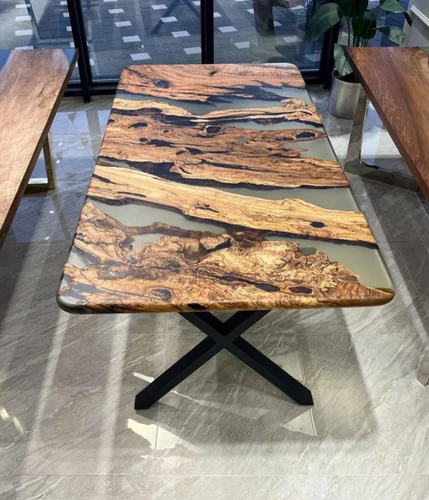
Epoxy: The most favored material in crafting these tables due to its strength, longevity, and transparent finish. It solidifies to a hard, often glossy surface that is resistant to water and abrasions, making it perfect for tabletops.
Polyester: This material hardens quickly and is less costly than epoxy but can be more fragile and prone to discoloration over time.
UV: A variant of epoxy that solidifies under UV light, used for smaller projects or as a topcoat because of its rapid curing time and transparent finish.
The Crafting Process
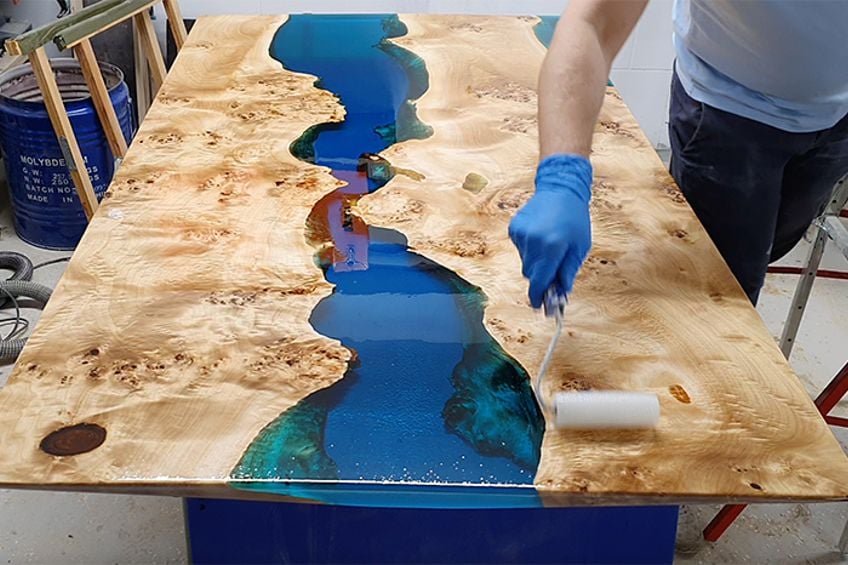
Creating a table involves several meticulous steps, demanding both accuracy and creativity. Initially, the design is decided, the type of wood is selected (if used), and the mold or work area is prepared with a release agent to prevent adherence. The epoxy is then mixed in the correct proportion, an essential step for proper curing.
During the pouring phase, artists can express their creativity by adding colors, pigments, and objects into the mix. Layers may be added to achieve depth or specific designs. The curing phase is vital for the material to harden and reach its final durability and appearance.
Finally, after curing, the piece is removed from the mold (if used) and undergoes finishing touches, such as sanding to remove any blemishes and applying a final coat or polish to enhance its luster and protect the surface.
Crafting these tables is as much an expression of artistry as it is a demonstration of skill, allowing for limitless creativity and resulting in unique pieces that enhance any contemporary living space.
The Art Behind the Epoxy
The creation of resin tables transcends conventional furniture design, venturing into the realm of personal expression and artistic craftsmanship. This process, inherently creative and meticulous, involves a deep understanding of the materials at hand and a visionary approach to design. Each table tells a story, shaped by the unique visions of its creator and the inherent beauty of the materials used.
The Creative Process
Designing a table begins with a vision, often drawn from the allure of nature, abstract compositions, or the aim to encapsulate a specific moment. Craftsmen contemplate the harmony of light, color, and texture, imagining the amalgamation of these elements in the final product.
The selection of foundational materials, like a particular wood type, lays the groundwork for this artistic exploration. Woods with pronounced grains, knots, and natural edges are typically chosen to enhance the liquid clarity and vibrancy of the material.
From this point, designers determine the color scheme, assessing how pigments will blend with the foundational material and among themselves. Options might include gentle gradients that echo natural landscapes, vivid colors for a dramatic effect, or a transparent finish to reveal the underlying beauty.
Techniques like swirling, layering, and incorporating items within the material infuse the piece with dimension and story.
Versatility in Design
The adaptability of this medium enables a wide array of designs, from minimalist and contemporary to rugged and natural. Integrating elements such as stones, shells, and metals into the medium can produce a visual and tactile juxtaposition, underscoring the balance between the untouched and the manufactured.
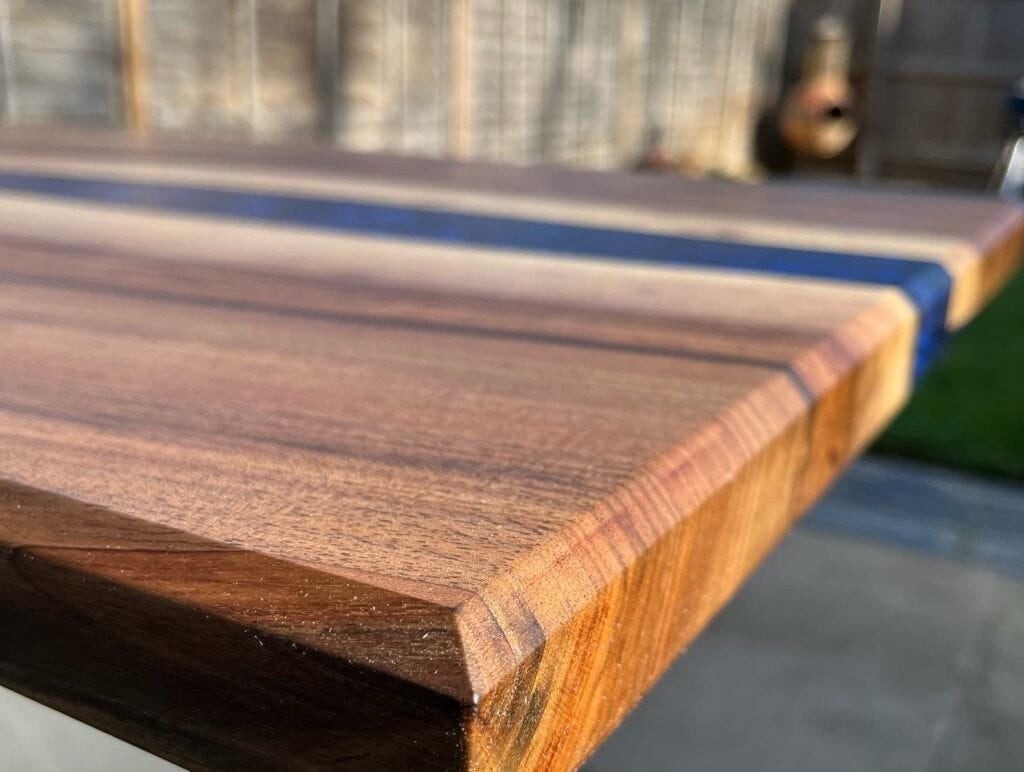
For instance, a table could showcase a stream of blue-tinted material coursing through a walnut slab, conjuring images of tranquil waterways meandering through a woodland. Alternatively, incorporating metallic powders or flakes within the medium can create a glistening effect, akin to a nocturnal sky glittering with stars.
Highlighting the Unique
Artisans often use resin to preserve and highlight natural features of wood, such as live edges or voids, turning perceived imperfections into focal points of beauty. This not only celebrates the uniqueness of the natural material but also ensures that no two tables are exactly alike.
The inclusion of LEDs beneath the resin or within these natural features can further enhance the table’s visual impact, creating an ethereal glow that transforms the piece at night.
The art behind epoxy in resin tables lies not just in the visual appeal but in the emotional resonance of the finished piece. It’s about capturing a feeling, a moment, or a piece of the natural world and immortalizing it in a functional piece of art. This creative process results in tables that are more than just furniture; they are personal artifacts, blending seamlessly with the modern home’s aesthetic while standing out as singular works of art.
Care and Maintenance
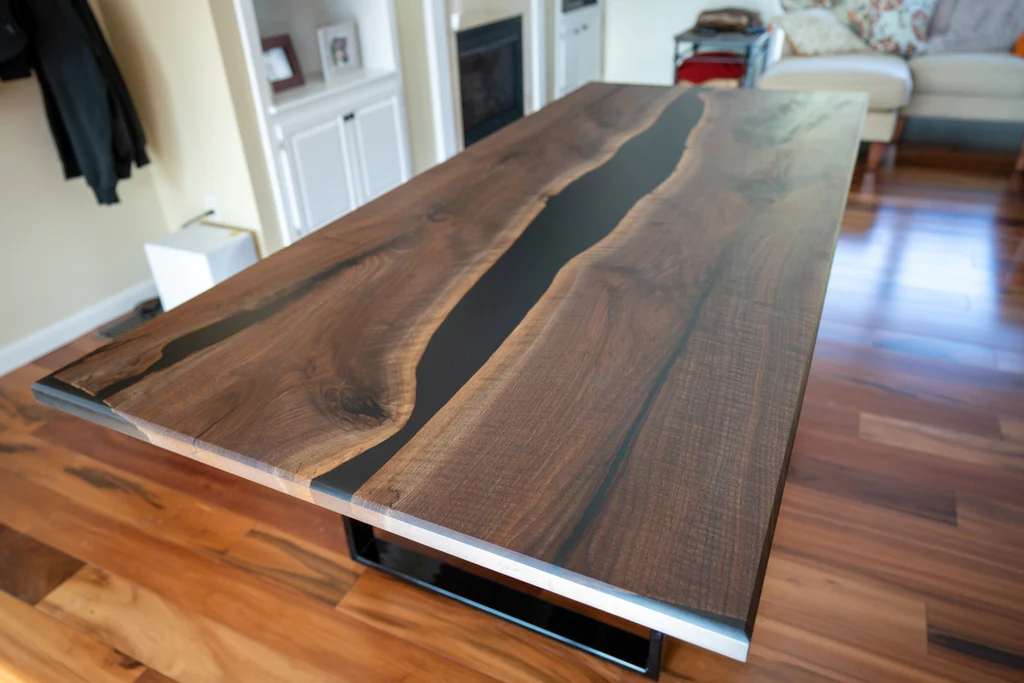
Tables crafted from this durable material are celebrated for their longevity and minimal upkeep requirements, attributes that have made them a popular selection for both homes and commercial settings. To ensure your table maintains its allure and utility over time, here are some crucial care and maintenance strategies, along with suggestions for addressing common concerns such as scratches and exposure to high temperatures.
Basic Maintenance Advice
- Routine Cleaning: A soft, damp cloth is typically all that’s needed for daily cleaning. For a more comprehensive clean, a gentle soap diluted with water is recommended. Steer clear of harsh chemicals or rough cleaning tools, as they can harm the table’s finish.
- Sunlight Protection: Although this material is robust, extended exposure to sunlight can cause fading or yellowing, particularly in clear or pale shades. Place your table in an area shielded from direct sunlight, or use curtains or blinds to limit its exposure.
- Surface Protection: To safeguard the table’s top from scratches and marks, employ coasters for glasses and placemats for dishes, especially when dealing with hot items, as excessive heat can damage the material.
- Sharp Object Precautions: Despite its resilience, the material is susceptible to scratches from sharp items. Refrain from slicing directly on it and utilize protective mats or boards as needed.
Addressing Scratches
- Light Scratches: Minor blemishes can often be remedied with a soft cloth and a gentle polishing agent suitable for this material or plastic. Conduct a patch test in a discreet area first to ensure it doesn’t affect the finish adversely.
- Significant Scratches: For more pronounced scratches, a light sanding with fine-grit sandpaper (e.g., 600-800 grit) followed by polishing may be required. Proceed with caution to avoid an uneven surface. If uncertain, seek professional advice.
Handling Heat
- Heat Damage Prevention: Always place trivets or heat-resistant mats under hot items to prevent softening or deformation of the material.
- Heat Mark Repairs: If your table exhibits signs of heat damage, such as cloudiness or a softened surface, it may require professional restoration. Occasionally, the damaged top layer can be sanded off and a new layer applied, though this is a task for specialists.
Ongoing Maintenance
- Wax Application: A coat of specific wax can offer additional protection, enhancing the table’s resistance to stains and scratches while boosting its gloss. Verify that the wax is compatible with this material.
- Periodic Checks: Regularly examine your table for wear or damage signs, like cracks or separation, which could signal deeper issues. Prompt identification allows for easier mitigation of potential problems.
Adhering to these care and upkeep instructions will help preserve the beauty and functionality of your table for an extended period. Consistent cleaning, shielding from damaging influences, and immediate attention to any harm will ensure your table remains as impressive as when first acquired.
Resin Tables in the Eco-Friendly Home
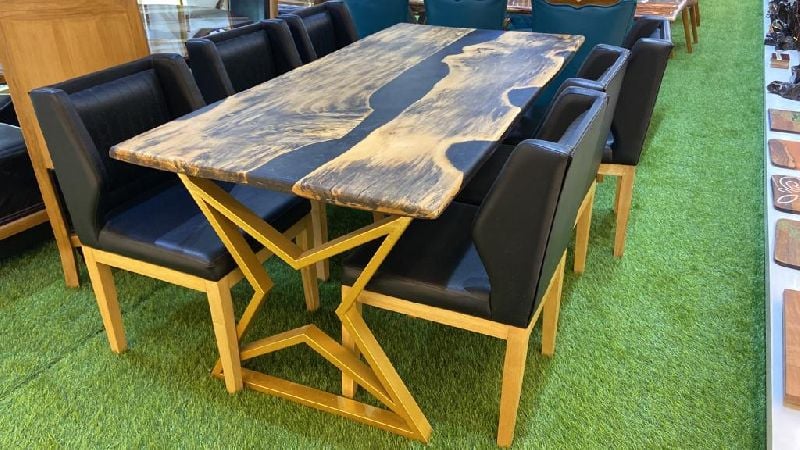
As the demand for sustainable and eco-friendly home decor rises, it’s essential to consider the environmental impact of all types of furniture, including resin tables. While resin tables offer durability and aesthetic appeal, their production and end-of-life disposal present challenges for eco-conscious consumers. Understanding these aspects and knowing how to source responsibly made resin tables can help mitigate their environmental footprint.
Environmental Impact
Resin Production: Traditional epoxy resins are derived from petroleum-based products, which means their production is reliant on fossil fuels. The manufacturing process can release volatile organic compounds (VOCs), contributing to air pollution and potential health hazards.
- Durability vs. Biodegradability: The durability of resin tables, while beneficial from a longevity standpoint, poses a challenge for disposal. Most epoxy resins are not biodegradable, which means they can persist in landfills for many years, potentially leaching chemicals into the environment.
- Energy Consumption: The process of curing resin, especially for large pieces like tables, often requires significant energy, contributing to the carbon footprint of the finished product.
Sourcing Responsibly
Eco-Friendly Resins: Look for tables made with eco-friendly resins, such as those derived from natural sources (like plant oils) or containing recycled materials. Some newer resins emit lower VOCs or are more energy-efficient in their curing process.
- Sustainable Wood and Materials: If the resin table incorporates other materials, such as wood, ensure these are sourced sustainably. Look for certifications like FSC (Forest Stewardship Council) or reclaimed wood, which indicate responsible sourcing.
- Local Artisans and Manufacturers: Purchasing from local artisans can reduce the carbon footprint associated with transporting goods. Local craftspeople are also more likely to use locally sourced and environmentally friendly materials.
- Durability and Repairability: Choose a table that is not only durable but also repairable. Being able to fix minor damages can extend the life of the table significantly, reducing the need for replacement and, consequently, waste.
Considerations for Eco-Conscious Consumers
- Lifecycle Assessment: Consider the entire lifecycle of the table, from production to disposal. Opt for manufacturers who use renewable energy and practice waste reduction in their production processes.
- Repurposing and Recycling: Think about the table’s end-of-life stage. Explore options for repurposing or recycling the table or its components to avoid landfill disposal.
- Educate Yourself: Stay informed about advancements in eco-friendly materials and manufacturing processes. The industry is evolving, and more sustainable options are becoming available.
- Supporting Sustainable Brands: By choosing to purchase from companies that prioritize sustainability, you encourage more eco-friendly practices within the industry.
Incorporating a resin table into an eco-friendly home requires mindful consideration of its environmental impact and a commitment to sourcing responsibly made products. By taking these steps, consumers can enjoy the unique beauty and durability of resin tables while aligning with their eco-conscious values, contributing to a more sustainable future for home decor.
Conclusion
In the journey through the world of modern home decor, resin tables emerge as a remarkable synthesis of functionality and artistry. These pieces transcend the traditional boundaries of furniture, offering homeowners a unique opportunity to infuse their spaces with both beauty and durability.
The process of creating a resin table—a meticulous blend of science and creativity—allows for the expression of personal style and the incorporation of natural and recycled materials, making each piece a one-of-a-kind work of art.
The versatility of resin tables, with their vast array of designs, colors, and incorporations, ensures that there is a table for every decor style, from sleek and modern to rustic and eclectic. Their durability and ease of maintenance make them a practical choice for everyday use, while their aesthetic appeal invites conversation and admiration, serving as a focal point in any room.
Moreover, the evolving landscape of eco-conscious consumerism has begun to shape the resin table industry, with artisans and manufacturers increasingly focusing on sustainable practices.

